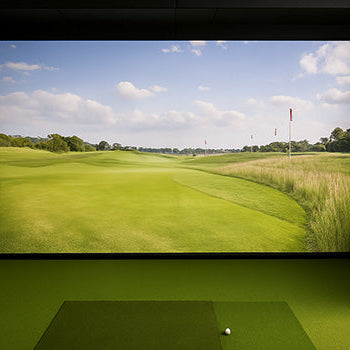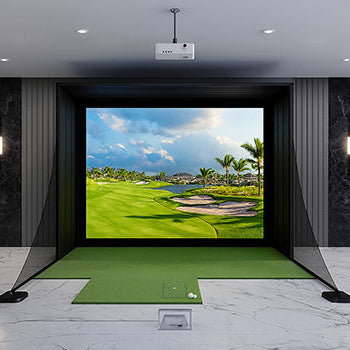Ever hit a perfect drive on a Golf Simulator and thought, “That’s a 300-yard bomb!”. Only to wonder if it would’ve even cleared the rough in real life? You’re not alone. Short answer: today’s top golf simulators are 95–99% accurate. That means what you see on screen is surprisingly close to reality. Curious why? Stick around as we dig into the tech behind the turf.

Defining Accuracy: What Do We Mean by "Accurate"?
When we talk about how accurate golf simulators are, we’re not just guessing how far your ball went. We're talking science, how well these machines measure your swing, the ball’s launch, spin, path, and everything in between.
Accuracy means replicating what would happen on a real course. And modern simulators are doing a great job. Here's how that breaks down.
Club Data Accuracy (e.g., Clubhead Speed, Path, Face Angle)
Let’s start with your swing. High-end systems can track your clubhead speed, swing path, and face angle with precision, down to fractions of a degree.
If you’re swinging 98.3 mph with an open face, the simulator knows. This data is usually accurate within 1–2%, which is more than enough to pinpoint what’s working, or what’s causing that annoying fade.
Ball Data Accuracy (e.g., Ball Speed, Launch Angle, Spin Rate)
Next comes the ball. Simulators equipped with Doppler radar or photometric sensors can capture ball speed, launch angle, and spin rate with astonishing detail.
You’ll see stats like “2600 RPM backspin” and “14° launch angle, and yes, they’re typically within 1–3 yards of real-life distances. This is the core reason players trust simulators for dialing in clubs and practicing indoors.
Shot Shape and Flight Path Realism
So, can golf simulators detect a slice? Absolutely. Thanks to sensors and high-speed cameras, they don’t just show the ball going right, they understand why it’s slicing. They measure spin axis, side spin, and club path in milliseconds.
The result? You’ll see realistic fades, draws, hooks, and the occasional dreaded snap slice, just like outdoors, minus the lost ball.

The Factors That Determine Simulator Accuracy
Not all simulators perform equally, and it’s not just about price. Setup, components, and even your golf ball can make or break the realism.
Let’s explore what really affects how accurate a simulator is.
The Quality of the Launch Monitor: The Single Biggest Factor
If there’s one thing that makes or breaks your simulator, it’s the launch monitor.
Think of it like your car’s engine. Budget systems give you a general idea of what’s happening. But top-tier monitors like TrackMan and Foresight GCQuad? They record everything from club impact to spin axis with near-lab precision.
That’s the difference between 80% accuracy and 99% accuracy. Don’t cheap out here if data matters to you.
The Environment: The Importance of Correct Setup and Lighting
Ever tried playing golf in a disco? Harsh lighting or poor room setup can completely mess with your sensors.
To get clean, consistent reads:
-
Use soft, even lighting (no spotlights!)
-
Keep the space climate-controlled
-
Avoid clutter around the hitting area
-
Make sure all sensors are aligned and unobstructed
Environmental stability keeps your data trustworthy.
The Golf Ball: Why Marked Balls Can Improve Readings
Some simulators love a flashy ball. Marked balls, the ones with spin markers or reflective dots, help systems read spin and direction more precisely.
Using range balls or worn-out gear? Your spin data could be off. It’s a small swap that leads to better, more consistent results.
The Hitting Mat: How It Influences Strike Data
Your mat isn’t just a landing pad. It’s part of the data chain.
A low-quality or overused mat can mess with strike feedback, launch angles, and even clubface readings. Good mats simulate real turf, allowing for proper feedback on fat shots, clean strikes, and divot patterns.
Think of it as your simulator’s turf reality check.
Comparing the Tiers: From Entry-Level to Tour-Grade
So how accurate are home golf simulators compared to the setups the pros use? It comes down to the gear, and the budget.
Accuracy in Entry-Level Simulators (Under £5,000)
Affordable systems are fun and decent for casual use. They provide general feedback such as swing speed and shot direction.
Expect 80–85% accuracy. Great for playing simulated rounds, but don’t rely on them for club fitting or tight swing analysis.
Accuracy in Mid-Range Simulators (£5,000 - £15,000)
Step into this range and you’re getting serious tools. These systems offer impressive accuracy, detailed ball tracking, and realistic visuals.
You’re now hitting 90–95% accuracy, and that’s good enough for practicing with purpose, especially in winter months or on rainy days.
The Gold Standard: How Accurate are Professional Systems like TrackMan and Foresight?
This is the level trusted by PGA pros and tour coaches. These top-tier systems are considered the gold standard for a reason.
They use radar and photometric cameras to track every millisecond of your swing and every inch of ball flight. Accuracy? 95–99%. Used for everything from club fitting to televised events, these systems are as close to the real course as it gets.
Where Simulators Excel and Where They Fall Short
Golf simulators are brilliant, but not perfect. Here’s what they nail and where they still need work.
Strengths: Full Swing, Ball Striking Data, Distance Control
Simulators absolutely shine in full-swing data. If you’re working on driving distance, swing path, or gapping your irons, they’ll give you fast, reliable feedback.
They’re especially great for learning consistency and dialing in distances. Every shot gives you a data-packed snapshot of what really happened.
Weaknesses: Putting, Short Game Nuances, Uneven Lies
Here’s where things get tricky. Most simulators struggle with:
-
Reading soft chips or delicate putts
-
Simulating break or green speed
-
Capturing real-world lies or awkward stances
If you’re serious about short game work, the simulator won’t cut it alone. You’ll still want to spend time on an actual putting green.

The Verdict: Are Golf Simulators Accurate Enough for Game Improvement?
Absolutely, yes. Golf simulators, especially mid to high-end ones, give you enough data and realism to improve your swing, track progress, and build consistency.
You won’t learn to read a sloping green or hit out of thick rough indoors, but for most golfers, a simulator is the ultimate all-weather training partner. And yes, if you slice it in the simulator, you’d slice it on the course too.
So are indoor golf simulators accurate? With the right setup, they’re a game-changing way to practice smarter, not harder.









